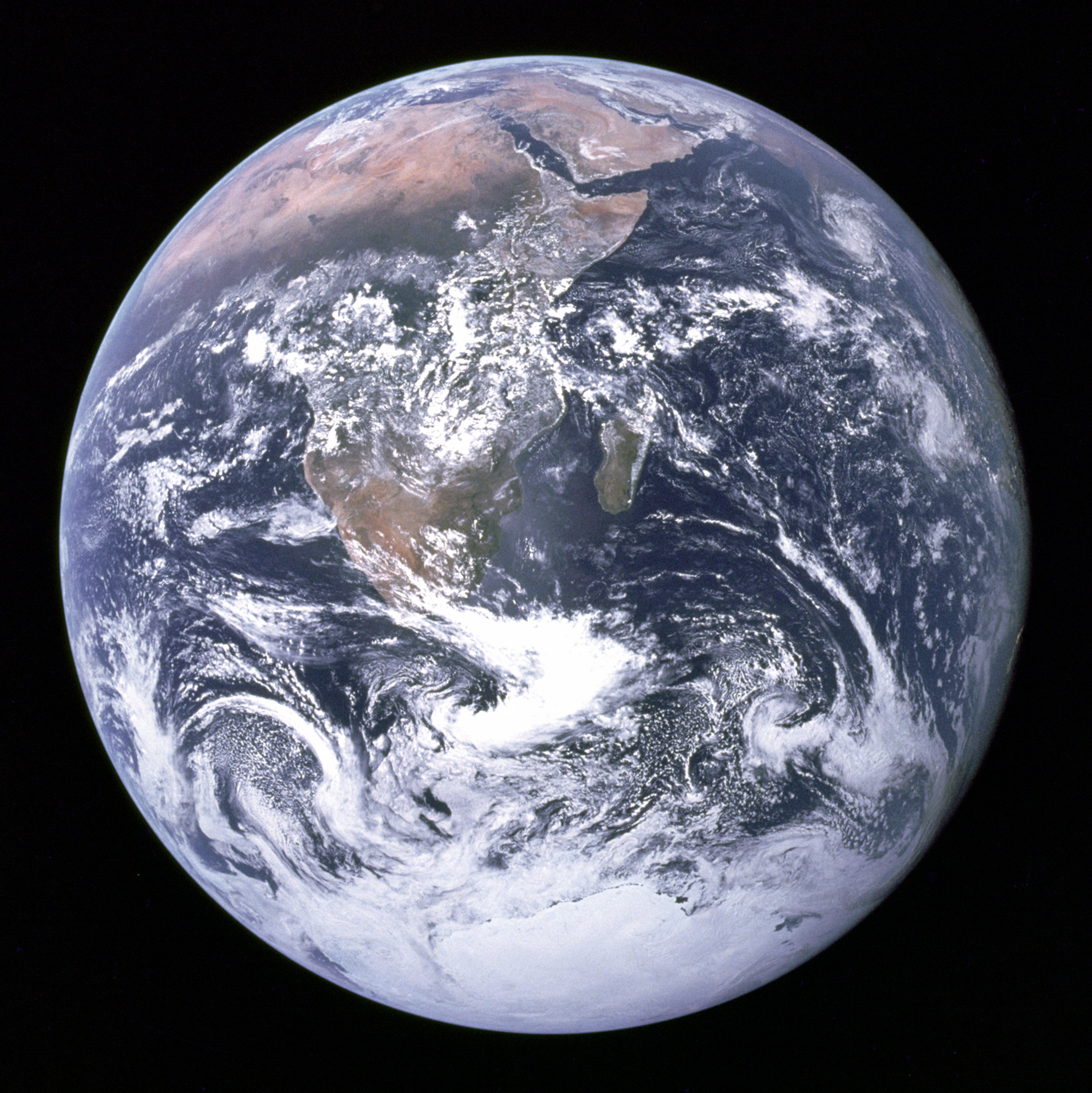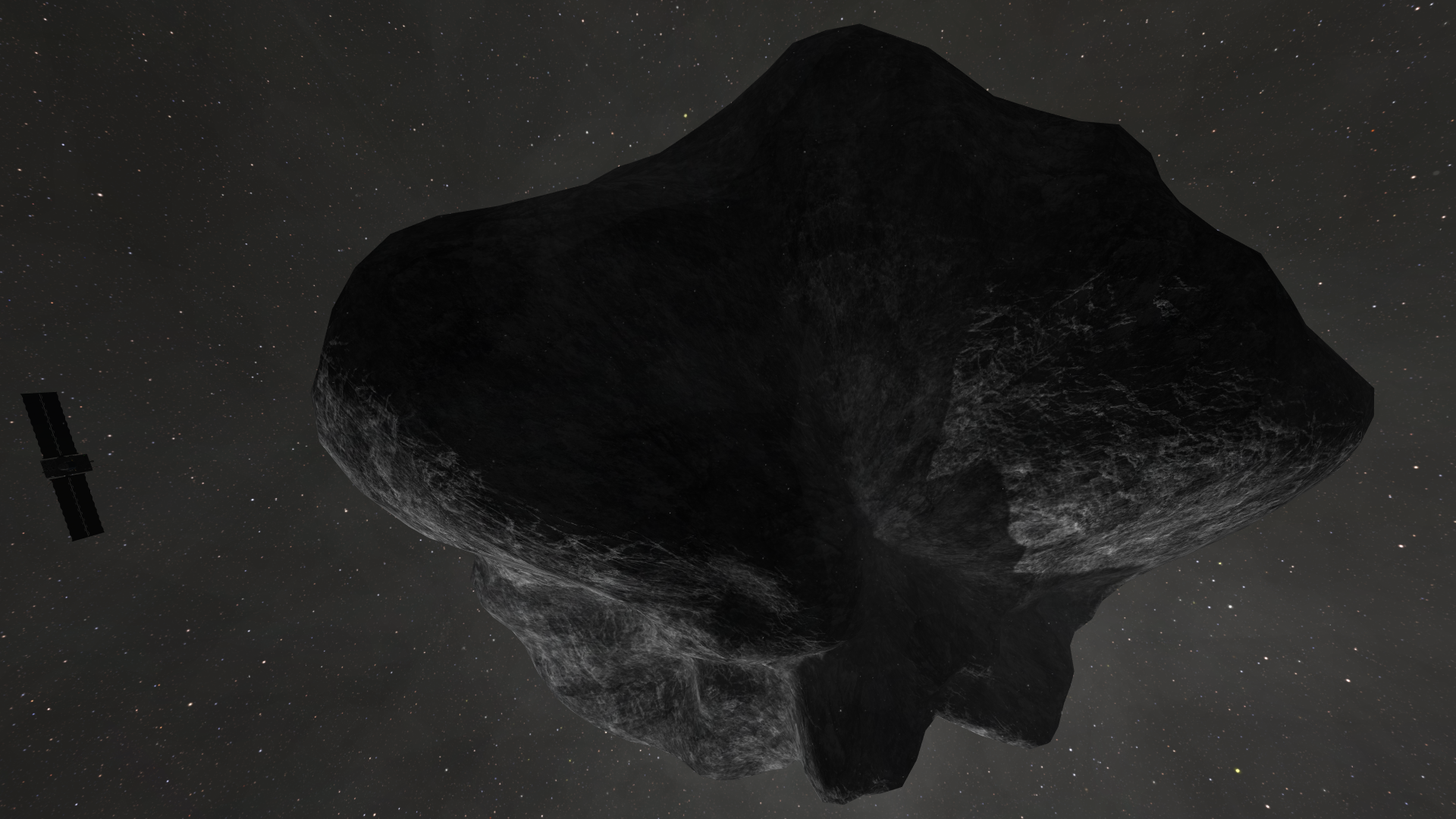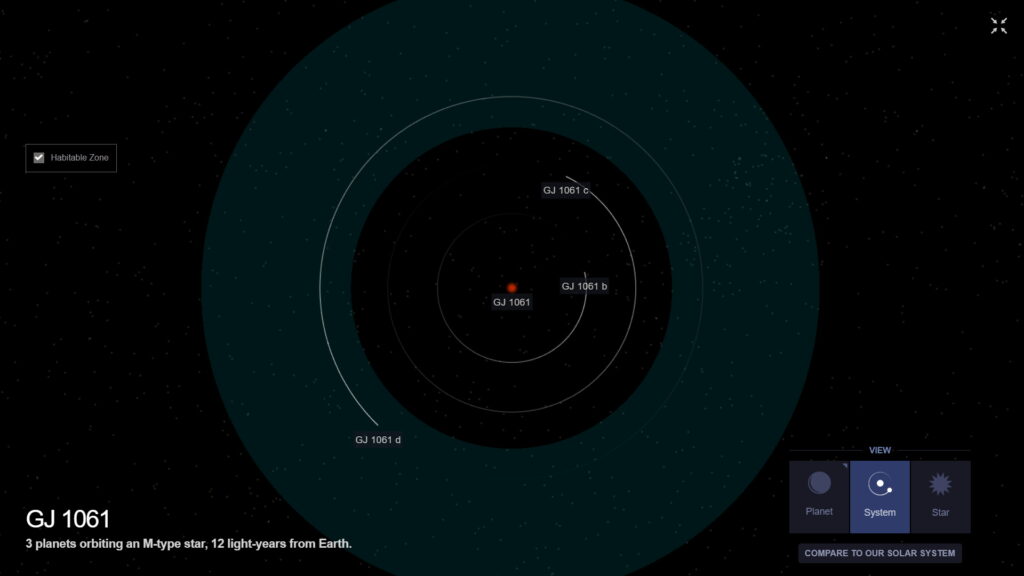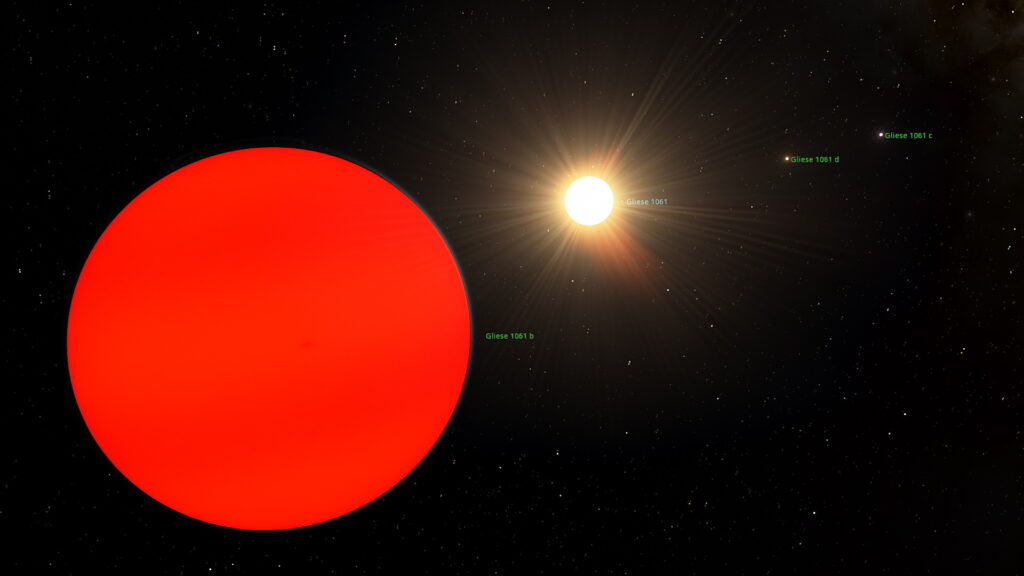 This will be a great week to observe the Moon in the early evening!
This will be a great week to observe the Moon in the early evening!
At 2:00 AM, the conjunction of Saturn and Jupiter appears in the east-southeastern sky, and Mars appears in the eastern sky, having risen shortly beforehand.
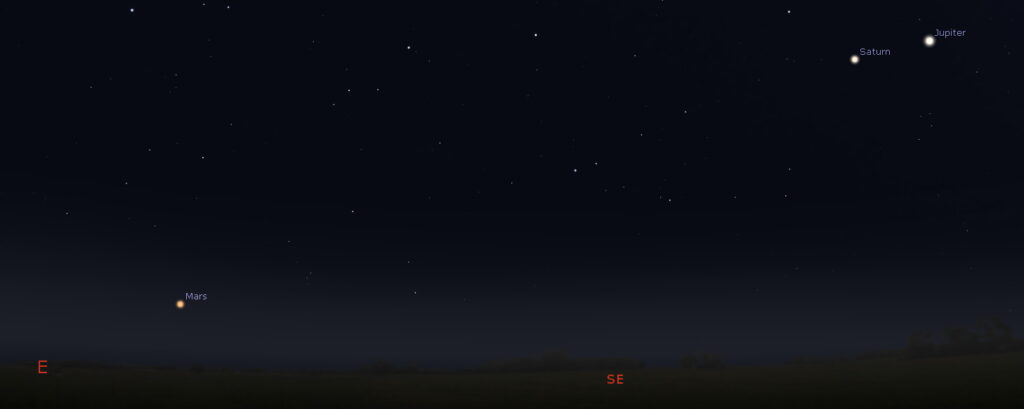 Saturn and Jupiter appear in the south-southern sky at 2:00 AM this week – Mars rises in the east shortly beforehand. Credit: Stellarium / Bob Trembley.
Saturn and Jupiter appear in the south-southern sky at 2:00 AM this week – Mars rises in the east shortly beforehand. Credit: Stellarium / Bob Trembley.Before dawn, Saturn and Jupiter have moved over to the southern sky, and Mars appears high in the southeastern sky
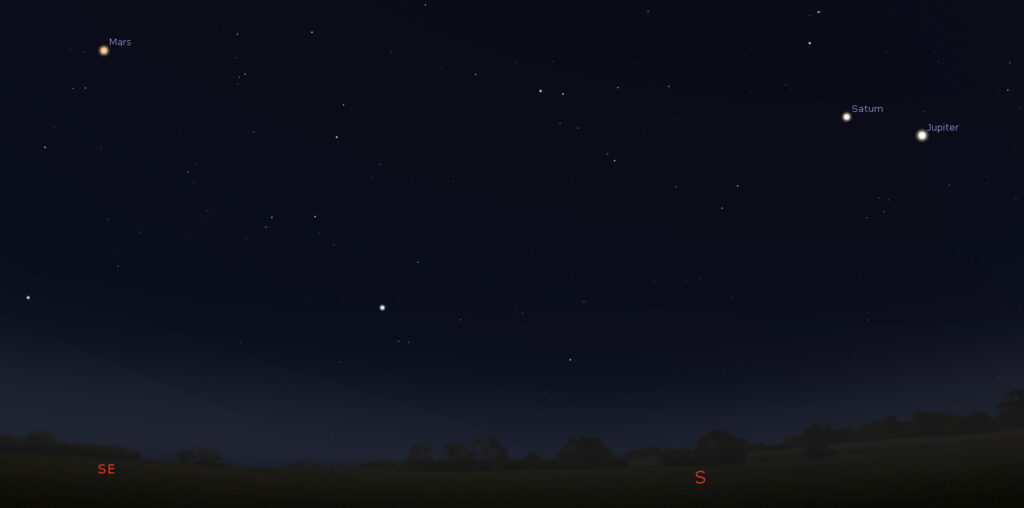 Before dawn, Saturn and Jupiter appear in the southern sky, and Mars appears high in the southeastern sky. Credit: Stellarium / Bob Trembley.
Before dawn, Saturn and Jupiter appear in the southern sky, and Mars appears high in the southeastern sky. Credit: Stellarium / Bob Trembley.

The Moon is be a waxing crescent – visible toward the southwest in early evening.
The first-quarter Moon occurs on June 28th – visible high in the southern sky in early evening.
After June 28th, the Moon will be a waxing gibbous – visible to the southeast in early evening, up for most of the night.
 The Moon from 2020-06-23 – 2020-06-29. Visualizations by Ernie Wright / NASA’s Scientific Visualization Studio.
The Moon from 2020-06-23 – 2020-06-29. Visualizations by Ernie Wright / NASA’s Scientific Visualization Studio.Moon News
Several years ago, I attended a meeting of Seven Ponds Astronomy Club where a former Apollo Mission Control engineer gave a talk – he mentioned that the Apollo landing sites are literally “garbage dumps!” Those bulky EVA suits – OUT the door! Garbage and “other waste” – OUT the door! Anything and everything that did not need to come back with the astronauts – OUT the door! Then the ascent stage lift-off blasted stuff all over the place… He was laughing at the thought of making the landing sites “protected historical monuments” before mankind eventually goes back to the surface of the Moon. He commented that the first humans to lay eyes on the Apollo landing sites are going to be a bit disappointed.

The Sun has been spotless for 7 days. Large coronal holes remain open at both poles, with a small group of coronal holes appearing near the center of the Sun’s face.
The Sun seen in 193 angstroms (extreme ultraviolet) June 22, 2020:
Several along-lived prominences with numerous short-lived pillars appearing for only a single frame in the video of the last few days of activity on the Sun.
The Sun seen in 304 angstroms (extreme ultraviolet) June 22, 2020:
You can view the Sun in near real-time, in multiple frequencies here: SDO-The Sun Now.
You can create your own time-lapse movies of the Sun here: AIA/HMI Browse Data.
You can browse all the SDO images of the Sun from 2010 to the present here: Browse SDO archive.
Facebook: SolarActivity – Run by Solar System Ambassador Pamela Skivak
https://www.facebook.com/photo.php?fbid=10163811091755274&set=pcb.3301909413153713&type=3&theater&ifg=1
https://www.facebook.com/photo.php?fbid=10163811090910274&set=pcb.3301908823153772&type=3&theater&ifg=1
https://www.facebook.com/photo.php?fbid=10222645098977050&set=gm.3300332426644745&type=3&theater
Solar Corona
Solar wind speed is 298.4 km/sec (↓), with a density of 6.2 protons/cm3 (↑) at 1330 UT.
Near real-time animation of the corona and solar wind from the Solar & Heliospheric Observatory (SOHO):
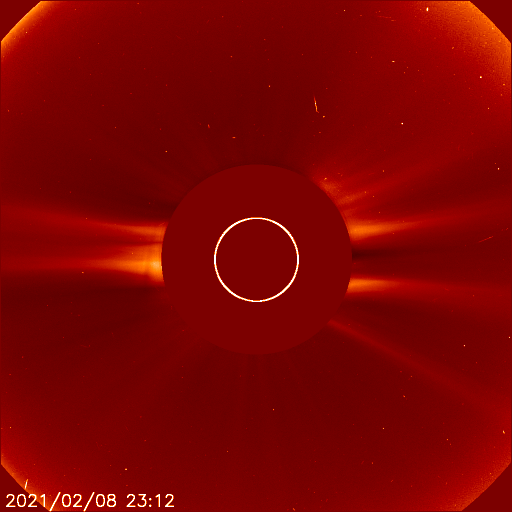 Animated LASCO C2 Coronograph showing the solar corona above the Sun’s limb (the white circle). Credit: NASA/JPL-Caltech-SOHO
Animated LASCO C2 Coronograph showing the solar corona above the Sun’s limb (the white circle). Credit: NASA/JPL-Caltech-SOHO

Potentially hazardous asteroids: 2037 (last updated June 2, 2020)
Total Minor Planets discovered: 958,881 (+167)
Upcoming Earth-asteroid encounters::
| Asteroid |
Date(UT)
|
Miss Distance
|
Velocity (km/s)
|
Diameter (m)
|
| 441987 |
2020-Jun-24
|
9.8 LD
|
12.9
|
186
|
| 2017 FW128 |
2020-Jun-25
|
6.9 LD
|
5.4
|
11
|
| 2020 MA |
2020-Jun-25
|
5.4 LD
|
7.8
|
32
|
| 2020 MK |
2020-Jun-27
|
12 LD
|
17.8
|
115
|
| 2020 MF1 |
2020-Jun-27
|
1.3 LD
|
10.5
|
10
|
| 2020 KQ7 |
2020-Jun-27
|
10.3 LD
|
2.6
|
18
|
| 2020 ME1 |
2020-Jun-28
|
2 LD
|
10.9
|
21
|
| 2020 JX1 |
2020-Jun-29
|
3.3 LD
|
5
|
62
|
| 2019 AC3 |
2020-Jul-01
|
10.5 LD
|
3.4
|
12
|
| 2020 MO |
2020-Jul-03
|
9.3 LD
|
9.6
|
41
|
| 2007 UN12 |
2020-Jul-04
|
16.7 LD
|
2.9
|
6
|
| 2020 LS |
2020-Jul-04
|
19.4 LD
|
11.6
|
73
|
| 2020 ML |
2020-Jul-12
|
11.4 LD
|
4.4
|
23
|
| 2020 KJ7 |
2020-Jul-13
|
11.9 LD
|
3.4
|
30
|
| 2009 OS5 |
2020-Jul-13
|
17.6 LD
|
2.6
|
45
|
| 2020 MX |
2020-Jul-17
|
15.1 LD
|
5.4
|
53
|
| 2016 DY30 |
2020-Jul-19
|
9 LD
|
15.1
|
3
|
| 2002 BF25 |
2020-Jul-21
|
9.4 LD
|
6.8
|
129
|
| 2018 PY7 |
2020-Jul-31
|
8.9 LD
|
9.5
|
16
|
| 2007 RF1 |
2020-Jul-31
|
10.7 LD
|
5
|
21
|
| 2018 BD |
2020-Aug-03
|
7.6 LD
|
9.4
|
3
|
| 2009 PQ1 |
2020-Aug-05
|
10.8 LD
|
13.5
|
112
|
Notes: LD means “Lunar Distance.” 1 LD = 384,401 km, the distance between Earth and the Moon. Red highlighted entries are asteroids that either pass very close, or very large with high relative velocities to the Earth. Table from SpaceWeather.com
Asteroid News
 On June 22, 2020, the NASA All Sky Fireball Network reported 23 fireballs.
On June 22, 2020, the NASA All Sky Fireball Network reported 23 fireballs.
(23 sporadics)
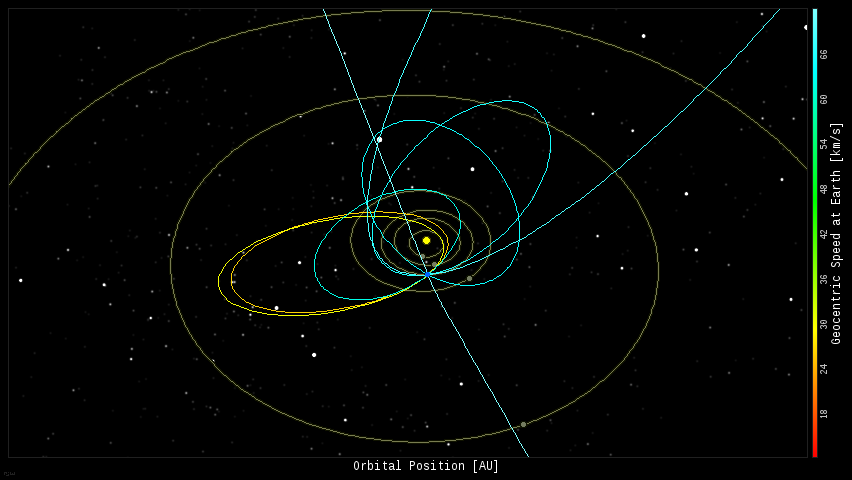 In this diagram of the inner solar system, all of the fireball orbits intersect at a single point–Earth. The orbits are color-coded by velocity, from slow (red) to fast (blue). Credit: SpaceWeather.com
In this diagram of the inner solar system, all of the fireball orbits intersect at a single point–Earth. The orbits are color-coded by velocity, from slow (red) to fast (blue). Credit: SpaceWeather.comFireball News
:/
https://twitter.com/UKMeteorNetwork/status/1275191746994061319
 Position of the planets and a couple spacecraft in the inner solar system:
Position of the planets and a couple spacecraft in the inner solar system:
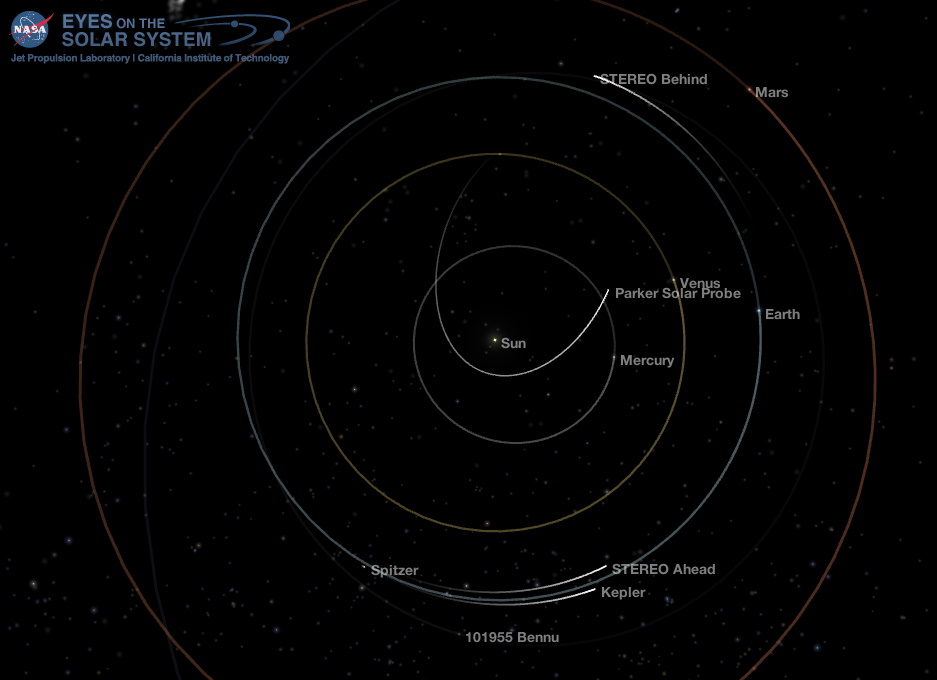 Position of the planets and a couple spacecraft in the inner solar system, 2020-06-23. Credit: NASA Eyes on the Solar System / Bob Trembley.
Position of the planets and a couple spacecraft in the inner solar system, 2020-06-23. Credit: NASA Eyes on the Solar System / Bob Trembley.Position of the planets in the middle solar system:
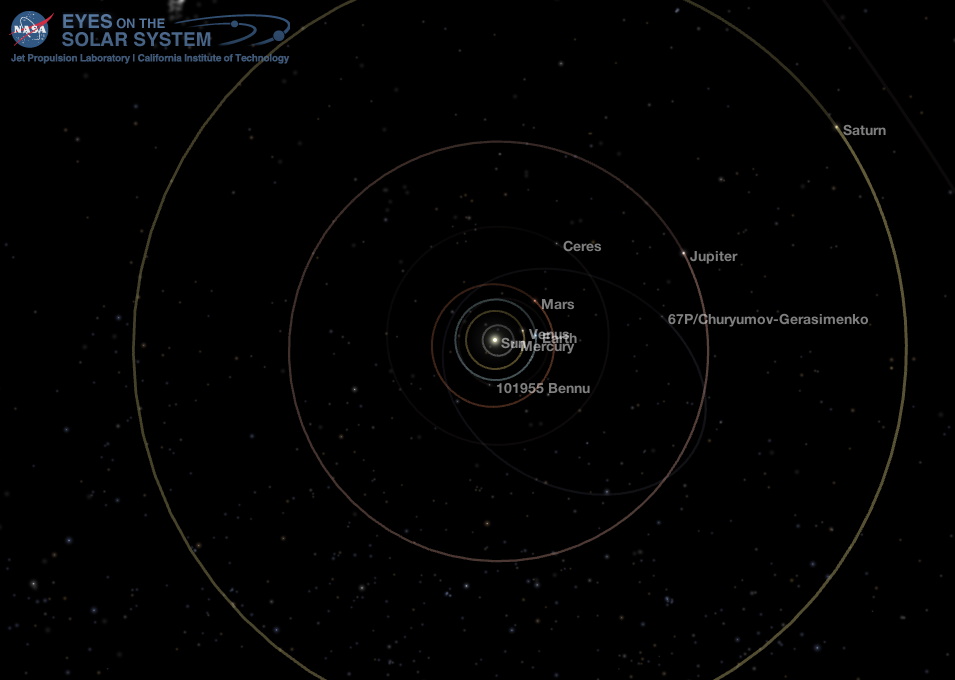 Position of the planets in the middle solar system, 2020-06-23. Credit: NASA Eyes on the Solar System / Bob Trembley.
Position of the planets in the middle solar system, 2020-06-23. Credit: NASA Eyes on the Solar System / Bob Trembley.Position of the planets some transneptunian objects in the outer solar system:
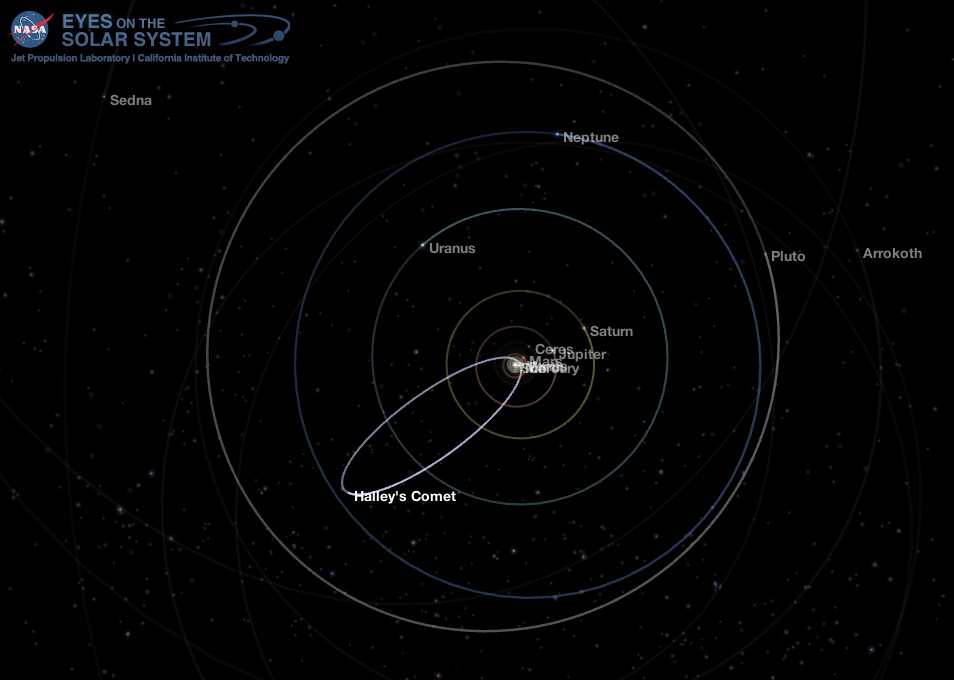 Position of the planets in the outer solar system, 2020-06-23 – the orbit of Halley’s comet is highlighted. Credit: NASA Eyes on the Solar System / Bob Trembley.
Position of the planets in the outer solar system, 2020-06-23 – the orbit of Halley’s comet is highlighted. Credit: NASA Eyes on the Solar System / Bob Trembley.Highlight: Planet Earth
“There’s no place like home”
Earth is the third planet from the Sun and the only astronomical object known to harbor life. According to radiometric dating estimation and other evidence, Earth formed over 4.5 billion years ago. Earth’s gravity interacts with other objects in space, especially the Sun and the Moon, which is Earth’s only natural satellite. Earth orbits around the Sun in 365.256 solar days, a period known as an Earth sidereal year. During this time, Earth rotates about its axis 366.256 times, that is, a sidereal year has 366.256 sidereal days.
Earth’s axis of rotation is tilted with respect to its orbital plane, producing seasons on Earth. The gravitational interaction between Earth and the Moon causes tides, stabilizes Earth’s orientation on its axis, and gradually slows its rotation. Earth is the densest planet in the Solar System and the largest and most massive of the four rocky planets.
Read more about Earth on the Wikipedia article – which is quite large.
Read more about Earth on NASA’s Solar System Exploration site: https://solarsystem.nasa.gov/planets/earth/overview/

OSIRIS-REx Asteroid Sample Return Mission
Mars Insight
International Space Station
NASA Perseverance Mars Rover
Hubble Space Telescope
Kerbal Space Program v. 1.10 debuts on July 1
KSP is adding ESA rocket and probe parts, comets and comet missions into the game! I can’t wait to run my first comet mission!
Climate

ex·o·plan·et /ˈeksōˌplanət/, noun: a planet orbiting a star other than the Sun.
Data from the NASA Exoplanet Archive
* Confirmed Planets Discovered by TESS refers to the number planets that have been published in the refereed astronomical literature.
* TESS Project Candidates refers to the total number of transit-like events that appear to be astrophysical in origin, including false positives as identified by the TESS Project.
* TESS Project Candidates Yet To Be Confirmed refers to the number of TESS Project Candidates that have not yet been dispositioned as a Confirmed Planet or False Positive.
 Hey! This was in Michigan! You GO students!
Hey! This was in Michigan! You GO students!
The Local Stellar Neighborhood
Continuing with my visual tour of nearby stars and their systems, we travel to Gliese 1061, about 12 light years distant.
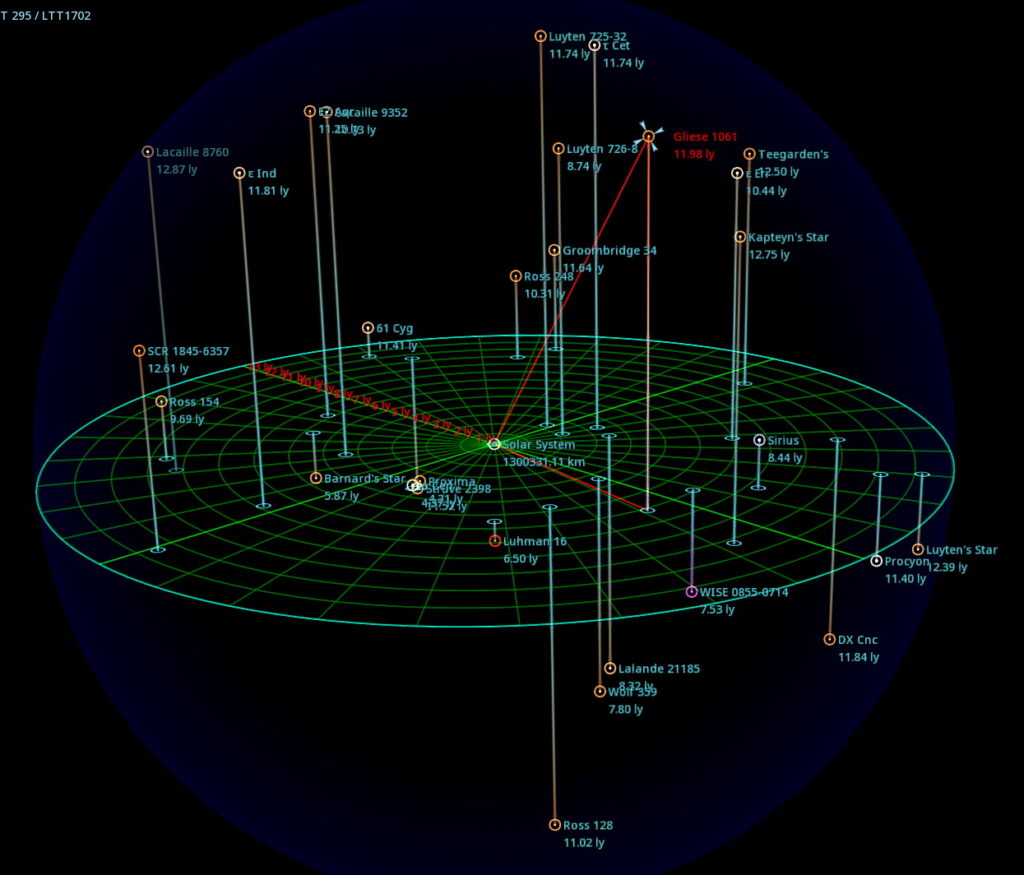 Distance to Gliese 1061 from Sol; the plane (green) is aligned with the orientation of the plane of the Milky Way galaxy. Credit: SpaceEngine / Bob Trembley.
Distance to Gliese 1061 from Sol; the plane (green) is aligned with the orientation of the plane of the Milky Way galaxy. Credit: SpaceEngine / Bob Trembley.Gliese 1061
Gliese 1061 is a red dwarf star located approximately 12 light-years from Earth in the southern constellation of Horologium. Even though it is a relatively nearby star it has an apparent visual magnitude of about 13 so it can only be seen with at least a moderately-sized telescope.
The proper motion of Gliese 1061 has been known since 1974, but it was estimated to be further away: approximately 25 light-years distant based upon an estimated parallax of 0.130″. Its distance was only accurately determined in 1997 by the RECONS team. At that time, it was the 20th-nearest star system to the Sun. The discovery team noted that many more stars such as this are likely to be discovered nearby.
This star is a very small, dim, red dwarf, close to the lower mass limit for a star. It has an estimated mass of about 11.3% of the Sun and is only 0.1% as luminous. The star has been examined for the presence of an astrometric companion, but none has been detected. Nor does it display a significant infrared excess due to circumstellar dust.
On August 13, 2019, a planetary system was announced orbiting the star Gliese 1061 by the Red Dots project of detecting terrestrial planets around nearby red dwarf stars. The planet, Gliese 1061 d, orbits on the conservative circumstellar habitable zone of its star and the planet Gliese 1061 c orbits in the inner edge of the habitable zone. – Wikipedia
Gliese 1061 System Architecture
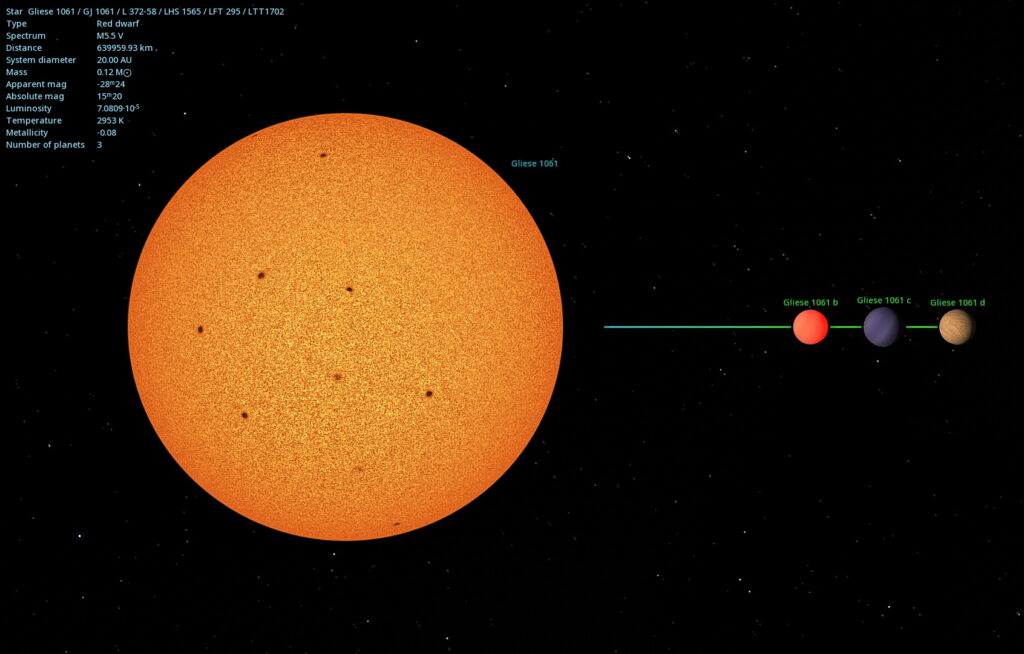 Gliese 1061 System Diagram. Note: Planet surface features are procedurally generated – artistic representations. Credit: SpaceEngine / Bob Trembley.
Gliese 1061 System Diagram. Note: Planet surface features are procedurally generated – artistic representations. Credit: SpaceEngine / Bob Trembley.Gliese 1061 Exoplanet Orbital Diagram
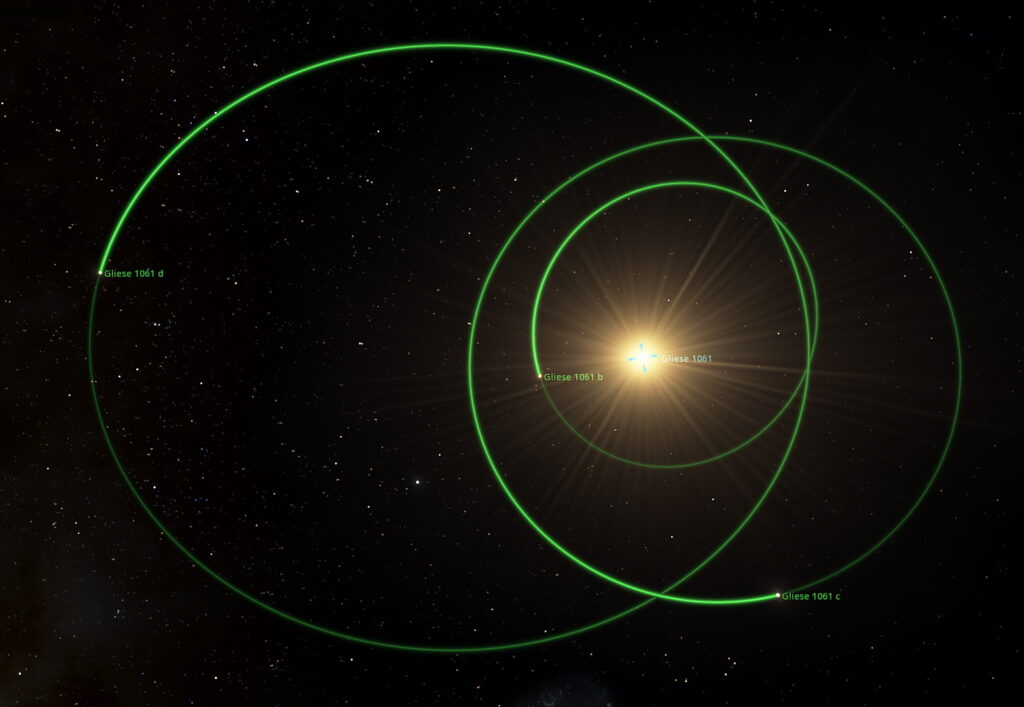 Top-down view of the exoplanet orbits around the red dwarf star Gliese 1061. Credit: SpaceEngine / Bob Trembley.
Top-down view of the exoplanet orbits around the red dwarf star Gliese 1061. Credit: SpaceEngine / Bob Trembley.The orbits in the image above caused my eyes to pop! The eccentricities of the exoplanets seem to be correct in SpaceEngine, with exoplanet Gliese 1061 d having a fairly high eccentricity of 0.54. However, the NASA Exoplanet site shows a different orbital diagram, and I’m pretty sure that none of these exoplanets are showing the slightest eccentricity – I’ve queried the Solar System Ambassadors about this.
Artist’s Rendering of Exoplanet Gliese 1061 d
Stay safe, be well, and look up!
Apps used for this post:
NASA Eyes on the Solar System: an immersive 3D solar system and space mission simulator – free for the PC /MAC. I maintain the unofficial NASA Eyes Facebook page.
Universe Sandbox: a space simulator that merges real-time gravity, climate, collision, and material interactions to reveal the beauty of our universe and the fragility of our planet. Includes VR support.
SpaceEngine: a free 3D Universe Simulator for Windows. Steam version with VR support available.
Stellarium: a free open source planetarium app for PC/MAC/Linux. It’s a great tool for planning observing sessions. A web-based version of Stellarium is also available.
Section header image credits:
The Sky – Stellarium / Bob Trembley
Observing Target – Turn Left at Orion / M. Skirvin
The Moon – NASA/JPL-Caltech
The Sun – NASA/JPL-Caltech
Asteroids – NASA/JPL-Caltech
Fireballs – Credited to YouTube
Comets – Comet P/Halley, March 8, 1986, W. Liller
The Solar System – NASA Eyes on the Solar System / Bob Trembley
Spacecraft News – NASA Eyes on the Solar System / Bob Trembley
Exoplanets – Space Engine / Bob Trembley
Light Pollution – NASA’s Black Marble
The Universe – Universe Today


